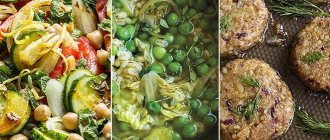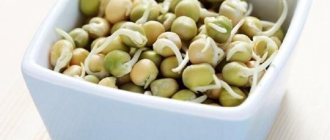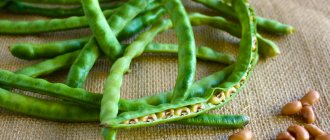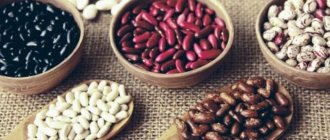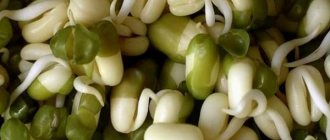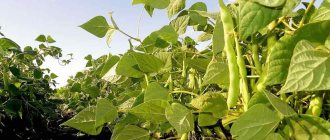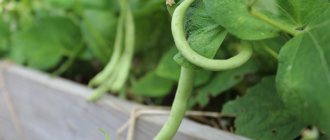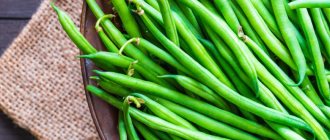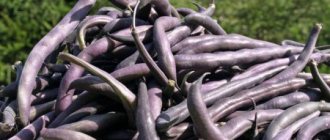What is cowpea
Cowpea is the common name of a genus of higher green angiosperms in the legume family (Fabaceae). The herbaceous plant is very close to the bean. Only in 1953, after genetic discoveries, Vígna was identified as a separate genus, which includes mung beans (we talked about it earlier), urd, adzuki.
There are 118 species in the genus Vigna, according to The Plant List database. The plants have a climbing or erect stem in a bush or semi-bush form; in some species it reaches 5 meters in height. It has trifoliate-pinnate leaves, yellow, white, light blue or purple flowers collected in a raceme.
The fruit is a narrow, elongated bean, often incorrectly called a pod. The length can reach 1 meter, has a light green color and small bean grains in the middle. The color of the grains depends on the type and variety, most often derivatives are red-brown.
Representatives of the genus are cultivated in all tropical countries. Used as
- vegetable,
- cereal,
- stern,
- green manure culture.
In industrial farming, the most common is Vīgna unguiculata, which has about 15 subspecies. Cultivated more than 6 thousand years ago in West Africa.
Botanical illustration from Francisco Manuel Blanco's book Flora de Filipinas, 1880-1883
The most famous subspecies is Vigna chinensis (known as Chinese mung bean, Cow pea, Long bean, Long bean) - an agricultural plant.
The following types are common:
- Vigna unguiculata variety dekin tiana - grows wild in western Africa;
- Vigna unguiculata variety cylindrical is the most widespread in Ethiopia;
- Vigna unguiculata variety sesquipedalis (another name for Yard Long beans) is a plant with the longest beans in the world (up to 1 meter), grown as a substitute for green beans;
- Vigna unguiculata variety of unguiculata (called Black-eyed pea) is a bean that brings good luck, the main ingredient of a New Year's dish in the southern states of America.
Vigna is a heat-loving plant that requires lighting. Previously it was cultivated only in the tropical zone. Nowadays it can be found in mid-latitudes. Recently, cowpeas began to be grown in the Altai Territory. Specialists from the Novosibirsk Institute were the first to study the culture and received two varieties that are included in the State Register as approved for use: Siberian size and Yunnan. They are able to bear fruit in a short time - 51-67 days. It is preferable to grow it indoors, but you can also get a harvest in an ordinary garden.
Cowpea in the wild (photo_Vigna_marina_Forest & Kim Star)
Archaeological excavations prove that Cowpeas originate from West Africa. Approximately 2-3 thousand years BC, it appeared in the Southeast regions of Asia. The first written mention of the plant dates back to 300 BC. Some species of Vigna were brought to the American continent with slaves during the period of European exploration of the continent (XXVII-XIX centuries).
Popular varieties
Gardeners often plant asparagus varieties of Vigna; they lack hard fiber and have a rather delicate taste.
Commonly planted varieties:
- Darla. Semi-bush variety. The length of the pods is from 30 to 40 cm. The yield of one bush reaches 3 kg. The fruits are rich in protein, carbohydrates, and microelements. Resistant to diseases.
- Makaretti is an early ripening variety that bears fruit 80 days from the date of planting. The bush often grows up to 3 meters, climbing. The pods are curved in shape, about 30 cm in length. The seeds are brown in color and are characteristically kidney-shaped. One bush can grow up to 3 kg of crop.
- Arzuki. The variety reaches a height of 50 cm, angular, fruits 5-8 mm, pubescent pods up to 15 cm. The chemical composition contains a lot of complex carbohydrates, protein, and starch. It has a delicate sweetish taste. Can only be eaten in cooked form.
- Countess - has a medium ripening period. The pod part reaches 50 cm. It is not capricious and does not require care. The pods have no fibers. The seeds are colored black. A heat-loving plant, the optimal temperature for its cultivation is 30-35 degrees. From the moment the first shoots appear, technical maturity occurs after 60 days. Can be used for making soups and salads.
- Mash. It is characterized by a rigid branched stem up to 1.5 meters with large leaves and stipules. The pods are multi-seeded, up to 20 cm. The beans themselves are smooth, yellow in color, sometimes with dark inclusions.
- The Chinese variety is an early ripening variety. The beans grow 12 cm in length. They are unpretentious in cultivation.
Main characteristics of culture
What kind of vegetable cowpea plant is this, how to get a harvest from it? First you need to know the main characteristics of culture.
The nutritional value of the grains is 347 kcal. In 100 grams:
- 25 g protein;
- 1 g fat;
- 62 g carbohydrates.
Green beans (shoulders) contain 44 kcal/100 g:
- proteins – 3.3 g ;
- fats – 0.3 g ;
- carbohydrates – 9.5 g .
Cowpea contains a large amount of protein, pectin, microelements against the background of a high (37-40 mg/100 g of product) vitamin C content. This makes it possible to put it on a par with momordica, kiwano, benincase, which are classified as functional foods.
Good to know! Functional nutrition is the consumption of foods (including vegetables) that contain substances that have a positive effect on human health and promote recovery from diseases.
Biochemical studies of cowpea are carried out in foreign clinics. The advantages and differences of the crop over beans are in the extended fruiting period from July to September, which allows you to use the fruits the whole season, slowly preparing them for the winter: freezing, canning, salting. The seeds of mature beans are dried and consumed as leguminous crops.
Externally, the plant resembles a bean . Asparagus forms are the merit of Chinese farmers. Over thousands of years, cultivation has occupied a special place in the culture of the people. Chinese beans, called gongdu, are prized for their special long fruits. Cowpea blades have a bean length of up to 1 m, are fiber-free, tender, and pleasant to the taste. Many people call it beans.
The growing season under good conditions stretches for 2-4 months, during which one individual produces up to 350 flowers. Most of them fall off without producing an ovary. The flowering process lasts from two weeks to one and a half months.
In addition, cowpea beans require heat . Seeds do not germinate at temperatures below 12°C. The liana does not develop if it is below 25 degrees and stops growing at +35°C. At high temperatures, not only does growth slow down, but the color and beans drop. When the thermometer drops below +5°C, the plant dies completely.
Cowpea harvest. The plant is often confused with green beans
Cowpea beans almost do not react to dry air , but the lack of moisture in the soil negatively affects the harvest. The soil should be moist throughout the growing season.
The plant is a short day crop . Under such conditions, its growing season is shortened, a smaller increase in green mass is observed, and productivity increases. With long daylight hours, productivity decreases.
The plant does not make any special demands on the soil , grows equally well on all types, and tolerates high acidity.
Advantages and disadvantages of the variety
The Vigna bean variety has no significant disadvantages. The variety is loved by many gardeners for its unpretentiousness and high yield.
Benefits of beans:
- High yield.
- Easy to grow.
- Juicy tasty pods.
- Can be planted in shade.
- Suitable for growing in acidic and alkaline soils.
- Universal use in cooking.
- Used in dietary nutrition.
- It has a high content of nutrients for the body.
Vigna beans are often used in dietary nutrition. Its pods are rich in all nutrients and keep you feeling full for a long time.
Planting, caring for and growing cowpeas from seeds
Knowing the characteristics of the plant, it is not difficult to grow it from seeds. With the exception of standard varieties, liana plants are grown in vertical culture. The green mass is growing enormously, so you need to take care of reliable support. Plants need to be provided with regular fertilizing, good water conditions, alternating abundant watering with loosening, which will certainly increase the yield.
Cowpea fruit
Site selection and soil preparation
For the plant, choose a bed that is well lit by the sun, protected from gusts of wind. It’s not a big deal if there is partial shade over the site for part of the day. This will stimulate fruit formation. For climbing varieties, it is necessary to provide supports or plant them near a hedge. Good predecessors would be:
- potato,
- tomato,
- eggplants,
- cucumbers,
- cabbage,
- carrot,
- parsley,
- celery,
- beet.
The soil is prepared in the fall by digging it to a depth of 20-25 cm (a full bayonet of a shovel), adding manure (1 bucket per square meter) and 30-40 g/m2 of superphosphate. In the spring, the bed is dug up and potassium fertilizers are applied at 25 g/m2.
Preparing and sowing seeds
Whole, undamaged grains are selected for sowing. For quick germination, they are soaked for 12 hours in water at room temperature. Before sowing, treat with a pale solution of potassium permanganate.
Cowpea seeds
The grains are planted in the holes made to a depth of 4 cm with an interval of 40 cm between plants. Before planting, the holes must be watered with warm water. After sowing, sprinkle with a layer of soil and cover with mulch on top to retain moisture as much as possible.
Landing dates
Cowpea loves warm weather, so for planting, choose the period when the average daily temperature reaches 15°C, and the soil temperature at the planting depth is more than 10°C.
If the weather is unstable, the temperature may drop, areas with plantings must be covered with agrofibre . Under favorable conditions, sprouts will appear 10 days after planting the seeds.
Watering and fertilizing
The plant loves moisture very much. Watering should be done once every 7-10 days. You shouldn't be too zealous. Excessive humidity will lead to an increase in green mass, which impairs flowering, and therefore the yield will decrease. The most critical periods when it is necessary to monitor soil moisture are flowering and ovary formation. During this period, watering should not be stopped, and any drying out of the soil will lead to the loss of established beans.
On a note! During the growing season, you need to feed the plants twice: 1 tablespoon of nitroammophoska is diluted in 1 bucket of water. Feed, combined with watering, using 10 liters of liquid per square meter.
During the dry season, plants can be sprayed with a solution of 2 teaspoons of nitroammophoska in 10 liters of water. To do this, choose late evening time, using naturally heated liquid. You can purchase fertilizer mixtures with microelements for legumes and apply according to the instructions.
Weeding and loosening
Weeding of plants is done after germination. The second weeding is done when the plants reach a height of 10 cm, hilling the lower part. Caring for cowpeas during the summer consists of weeding and loosening the soil. Do this after each watering, preventing crust formation and moisture loss. Weeds can be used instead of mulch.
Installing supports and pinching vines
It is necessary to provide for the installation of a support immediately after sowing. To do this, you can plant plants near existing fences, fences, gazebos. If they are absent, a special trellis is built.
The vines of cowpeas develop very quickly, so you need to carefully tie them to a support, directing the stems in the desired direction. To stop the growth of the shoot and accelerate the formation of fruits, the vine is pinched. This is done with a sharp knife or pruning shears dipped in a solution of potassium permanganate.
Pest and disease control
Not so often, but sometimes cowpeas are affected by aphids. To avoid such consequences, it is necessary in the spring to begin fighting ants that breed aphids. If there are a lot of aphids, they can weaken the plant so much that it will lead to its death.
Bruchus is a typical pest of all legumes
When bad insects appear, you must use an insecticide. An example is “Bombardir” - a drug with the active substance imidacloprid, systemic-contact action. The same active ingredient has:
- Uppercut,
- Angio,
- Gunner,
- Confidor,
- Reading,
- Commander and others.
Spray according to the instructions before the flowering phase begins. After the formation of the ovary begins, biological preparations are used, treating the plants with infusions of garlic or celandine.
Care
Vigna beans are low maintenance. It only needs regular weeding, loosening the rows and timely watering for the crop to produce a good harvest. When the vines reach a length of 50 cm, they will need support for further growth. In this case, use any frame structures or stretch the mesh and direct the shoots towards it.
This crop tolerates drought well. Therefore, there is no need to water it often. It is enough to irrigate once a week. In this case, water consumption will be up to 30 liters per 1 sq. m. landing.
Important!
During the fruit formation stage, plants need much more moisture. Then the bushes are watered every other day. For irrigation, use warm, settled water that has warmed up in the sun during the day. When watering, weather conditions are taken into account.
Fertilizers are applied regularly, but in moderate dosage, so as not to activate the growth of green mass. It is more convenient to combine fertilizing with watering. For the first time, the bushes are fed 1 month after planting. At this time, plants need nitrogen.
Subsequent feeding is carried out with substances that the plant currently needs. 15 g of superphosphate and 5 g of potassium chloride are diluted in 10 liters of water. A furrow 5 cm deep is made along the entire row and the prepared solution is poured into it. Then the bed is loosened and mulched.
Growing cowpea seedlings
In the middle zone, it is better to grow cowpea in open ground in seedlings, and in the northern zone - in protected ground conditions or in greenhouses.
How to sow cowpea seedlings
Prepared seeds are planted in separate pots, half-liter disposable glasses or peat tablets to a depth of 1.5-2 cm. After the sprouts appear, provide light conditions and watering to avoid stretching fragile plants. The seedlings are not picked because they do not tolerate it well. Plant immediately in a permanent place of growth, taking care of the supports.
When growing indoors or in a greenhouse, care must be taken to ensure that condensation does not collect on the surface of the leaves, otherwise fungal diseases (for example, gray rot) may appear.
Green beans: two types under one name
Vegetable bean dishes, first tried by Europeans in the 18th century, were made from the Phaseolus vulgaris bean species brought from the American shores by the Spaniards and Portuguese. Over the past centuries, many productive varieties of common beans have been developed, including those that do not form a parchment layer inside the blades. Such plants produce elongated, cylindrical dietary beans that retain the juiciness of the leaves for a very long time.
In addition, today gardeners and adherents of a healthy lifestyle are offered to try numerous and very interesting varieties of green beans from the Asian region. This is the cowpea bean or cowpea, several varieties of which are grouped under the name Vigna unguiculata.
The peculiarity of this type of bean is its long, round pods in cross section. If the pods of green beans of domestic, European or American selection do not exceed 40 cm in length, then cowpea beans, with proper care, can easily grow to a meter in length. Due to their unusual appearance, beans are sometimes called snake beans in China and the West.
The closest relatives of this kind of asparagus bean shown in the photo are butterfly beans from India, mung beans and a number of species common in Africa, the Asian region and the Middle East. At the same time, both types of green beans are annual plants, cultivated as bush or climbing forms and producing not only juicy pods, but also edible, nutritious seeds of various sizes and colors.
Unlike American varieties of green beans, which are necessarily subjected to heat treatment, cowpea beans of milky-waxy ripeness can be safely eaten raw. Small cowpea seeds are useful not only in traditional dishes, but also sprouted. The only drawback of this amazing green bean is its heat-loving nature, so in central Russia the plant can often be seen in greenhouses, where Asian beans bring a stable harvest of pods and seeds for sowing. To speed up the production of cowpea beans, you can:
- choose bush varieties of green beans, which tend to ripen faster than climbing plants, but their beans are much shorter;
- give preference to Chinese or domestic varieties and hybrids, which are less whimsical than Japanese varieties.
Recently, American-bred cowpea beans have become popular. Asparagus varieties of common beans are not becoming less in demand.
Harvest and storage
The start of harvest depends on the variety. Technical ripeness of the blades occurs two months after emergence and lasts for a month and a half. To harvest asparagus fruits, they are removed when the seeds reach the size of a cereal grain. At this time they are most delicious. The more young fruits are removed, the more new ovaries are formed. Green beans can be consumed fresh, stewed, or boiled. The shelf life of the blades is 2-3 days in the refrigerator, so they can be frozen or canned.
Peas on a layout in Singapore
To enhance the taste and preserve all nutrients, asparagus beans are blanched.
Recipe: Winter preparation from cowpeas.
We will need cowpea fruits, which need to be washed well, cut into pieces that will fit in a canning container, placed in a colander and blanched in boiling water for 5-6 minutes. After this, pour cold water over it and let it drain well.
Place garlic and spices to taste in a prepared glass container: dill, parsley, black peppercorns, bay leaf.
Prepare marinade for 1 liter of water:
- 1 tablespoon salt,
- half a glass of sugar,
- 3 tablespoons 9% vinegar.
Place the beans in jars, pour marinade, not reaching 1 cm to the neck level, sterilize: half-liter jars - 10 minutes, liter jars - 15 minutes. Roll up and turn the lid down. After complete cooling, take it to the basement.
Cowpea beans
Cowpea seeds fully ripen in three months. To obtain seed material, the most developed beans are left on the best plants. Grains are stored in the same way as beans, in cool, dry rooms.
Diseases and pests of cowpea - how to fight
Cowpea basically suffers from the same diseases and pests as other legumes (more about this here, follow this link)
The main preventive methods of controlling diseases and pests include: timely removal of all plant residues and preparation of seeds for sowing. To prevent plants from being damaged by root rot, nematodes and aphids, crop rotation is required.
Agrotechnical control methods are aimed at timely tillage, weed control, application of balanced mineral fertilizers, and creation of optimal conditions for plant growth and development.
So. In severe drought conditions, spider mites actively reproduce, so it is necessary to sprinkle water to increase the relative humidity.
Cowpea beans taste best 7(min)-11(max) days after the ovaries form.
The beans are harvested after three days because they very quickly become tasteless and hard even after long cooking.
If you grow a variety with short beans, then they can be harvested when they reach an average length of 15 centimeters. Varieties with long ones at 30.
Another advantageous difference between cowpeas and beans is that they bear fruit before the first autumn frosts.
Keep in mind that young cowpea beans deteriorate very quickly - within 72 hours after harvesting they become lethargic and look unsightly.
Cowpea beans are stored at a temperature of 5 to 10 degrees Celsius.
Application of cowpea vegetable
Cowpeas are eaten with green beans, ripened grains, and leaves. The stems are fed to animals or processed to extract fibers from which ropes are made.
Tall cowpea tied to a trellis
Cowpea is used for treatment in folk medicine:
- Decoctions of beans and seeds have a diuretic effect and lower blood sugar levels.
- Tea made from flowers helps break up kidney stones and is used to treat diseases of the urinary organs.
- Porridges made from grains are indicated for joint diseases and inflammatory processes in the kidneys. The puree will be useful for gastritis, anemia, diseases of the liver, gall bladder, and pancreas.
- The presence of sodium and potassium in green beans will help relieve swelling, and their low calorie content will help you lose excess weight.
- Cowpea is used to regulate the functioning of the heart and vascular system.
- Cowpea flour is used to make a dough that helps get rid of abscesses and boils.
- A large amount of magnesium makes the product useful for people whose work involves stress. Stewed beans will help you get rid of irritability and increase the stability of the nervous system.
The use of cowpea in cooking is very wide. It is used to prepare salads, first courses, side dishes, main courses, even desserts.
Recipe: Cowpea green bean omelette.
Rinse the beans well, cut into 3-4 cm pieces, blanch in boiling water for 5 minutes, cool. Fry meat or bacon (any smoked meat you like) in a frying pan in vegetable oil, put cowpeas on top, and pour in beaten eggs. Grate the cheese on a coarse grater, sprinkle with paprika and cover with a lid. Keep on low heat until done. Sprinkle with your favorite herbs before serving.
Interesting Facts
Galloping John
- When germinating, seeds consume three times more water than they weigh.
- The genus Vigna in English sounds like Vigna. Named after the director of the Botanical Garden in Pisa, Italian botanist Domenico Vigna .
- A traditional dish of the southern states of America is “Hoppin ' John”, the main ingredient of which is cowpea, an affordable delicacy of slaves from the Congo. It is now traditionally eaten on the first day of the new year, a tradition that brings good luck and wealth.


